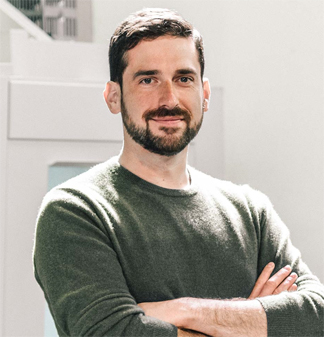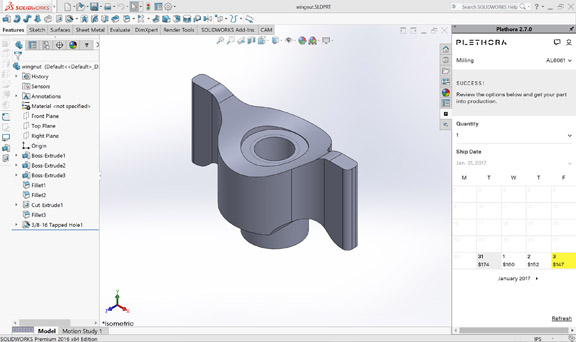
Latest News
January 26, 2017
 Plethora’s cofounder and CTO Jeremy Herrman (photo courtesy of Plethora).
Plethora’s cofounder and CTO Jeremy Herrman (photo courtesy of Plethora).Jeremy Herrman sits at the intersection of hardware and software, in a manner of speaking.
Growing up around his parents’ craft and woodworking business, he picked up the skills to use different types of saws and CNC routers to cut, sand, and shape objects. With a computer engineering background in his education, he and his friends regularly peruse Hacker News for job leads, projects, and tech gossips. He was the first software engineer to join Carnegie Mellon University’s Immersive Learning Technologies team.
Perhaps it was inevitable that he should cross path with Nick Pinkston, a fellow Pittsburgh resident and a 3D printing enthusiast. In his LinkedIn page, Pinkston declares he intends to “democratize the means of production to allow physical products to be created as easily as an iPhone app.” The two eventually cofounded Plethora, a software-driven part factory based on San Francisco. Herrman is the company’s CTO, and Pinkston is its CEO.
First Research, a market analyst, tallied up the machine shops in the U.S. in its Machine Shops Industry Profile report. There are about 20,000 of them. That’s more than the number of ubiquitous Starbucks coffee houses in the U.S., reported to be at a little more 13,000 by Statista. So how can Plethora distinguishes itself from the rest? The key is the CAD-embedded plugin from Plethora.
Once installed, the plugin appears as a tab inside the CAD program. Running in the background, it checks your part geometry for manufacturing issues and suggests fixes. It works like a general purpose CAM (computer-aided manufacturing) plugin, but it’s specific to the Plethora production facility’s manufacturing process.
“You can’t guarantee manufacturability unless you know everything about the factory,” Herrman says. “Our entire factory is communicating with the software, so the software knows every machine, every tool, every stock size available, also our production capacity.”
Plethora produces the parts onsite using its production machines. It doesn’t outsource the job to someone else. Since the software is intimately linked to Plethora’s operations, it can offer instant price estimates for jobs, with the option to pay more for speedy delivery or wait longer and pay less.
By contrast, Fictiv, another San Francisco-based company, allows you to upload a part’s 3D geometry from a browser and check manufacturability. Afterward, the company uses its vetted network of machine shops to make the part for a fee. (For more on Fictiv, read “Fictiv: Manufacturing for the Masses,” July 2016.)
The advantage of the Plethora plugin is, Herrman points out, “the instantaneous in-context feedback.” Since the plugin is running alongside your CAD program, you can initiate a manufacturability check at any phase or after any major geometry edit. You don’t have to wait until the job is finished to submit it for QA. In fact, if you’re cost sensitive, you may even refine your geometry with the plugin’s assistance to keep the production cost low.
 SOLIDWORKS-embedded Plethora plugin analyzing a part for manufacturing issues (image courtesy of Plethora).
SOLIDWORKS-embedded Plethora plugin analyzing a part for manufacturing issues (image courtesy of Plethora). Plethora plugin issuing price quotes and estimated delivery dates (image courtesy of Plethora).
Plethora plugin issuing price quotes and estimated delivery dates (image courtesy of Plethora).“Our software is where the magic happens. We’re first and foremost a technology company. Software is at the forefront of our business,” Herrman says. A significant portion of Plethora’s workforce—45 employees at the present—is devoted to the software. Since Plethora’s business model is to generate revenues from part production, the company gives away its CAD plugin for free. It’s available for Autodesk Inventor and SOLIDWORKS.
There is no minimum quantity requirement with Plethora, according to Herrman. “We can make one just as easily as we can a hundred,” he adds. “Our specialty is in low-volume production runs.”
Plethora currently offers only CNC services, but the company plans to add other production methods.
The gap between what can be modeled in a CAD program and what can be manufactured in a shop is gradually closing, in large part due to additive manufacturing (AM) or 3D printing machines’ ability to produce complex, detailed, asymmetrical geometry at a reasonable cost. But for small design shops, inventors, and startups who aren’t ready to mass-produce items, vendors like Plethora and Fictiv will continue to fulfill a need.
Subscribe to our FREE magazine, FREE email newsletters or both!
Latest News
About the Author
Kenneth Wong is Digital Engineering’s resident blogger and senior editor. Email him at [email protected] or share your thoughts on this article at digitaleng.news/facebook.
Follow DE





